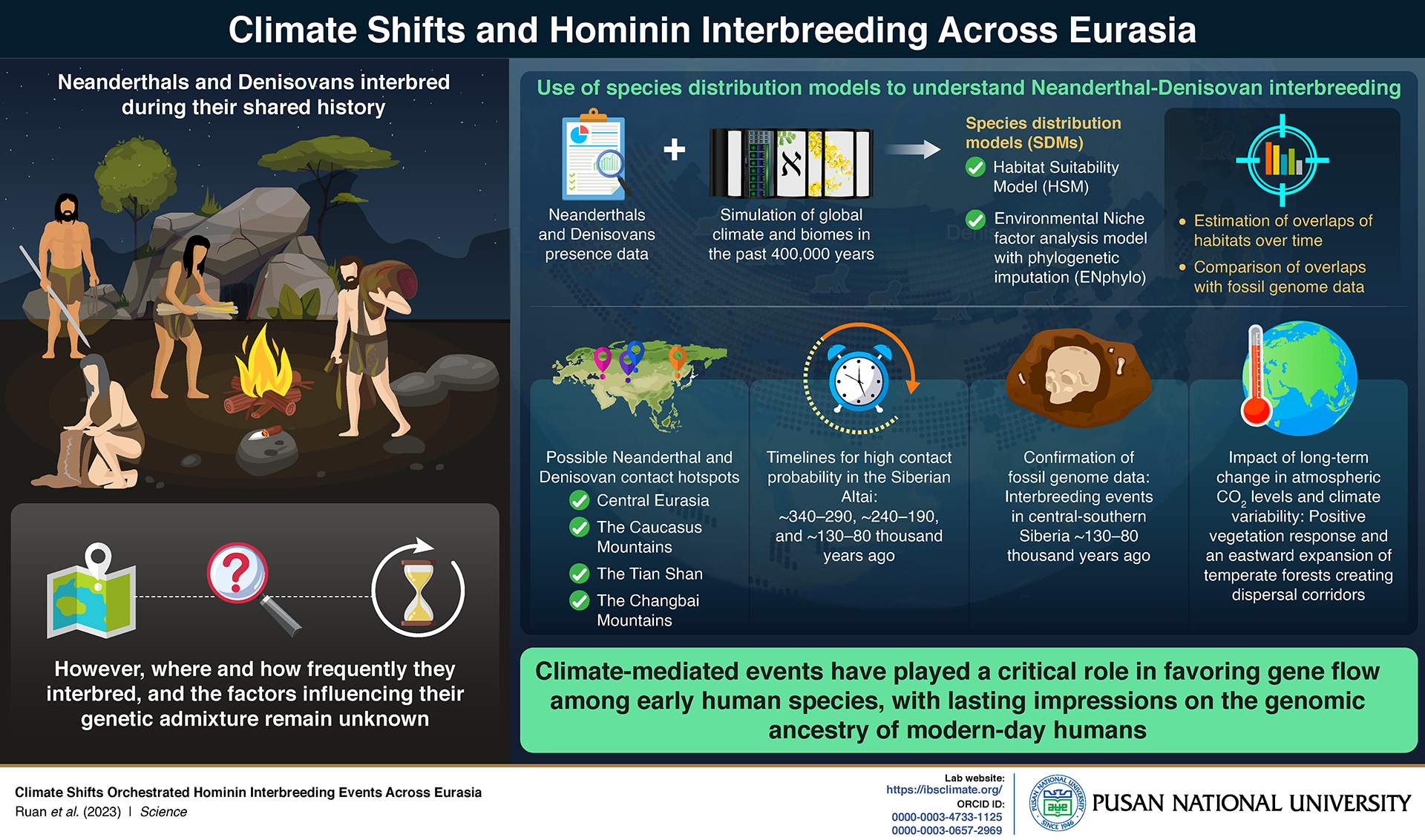A study published in Science indicates that climatic shifts over the past 400,000 years have influenced Neanderthal and Denisovan interbreeding.
 Multiple models demonstrate how glacial cycle variability synchronized hominin habitat overlap, Denisovan-Neanderthal interbreeding, and early human gene flow. Image Credit: Axel Timmermann
Multiple models demonstrate how glacial cycle variability synchronized hominin habitat overlap, Denisovan-Neanderthal interbreeding, and early human gene flow. Image Credit: Axel Timmermann
Recent paleogenomic research revealed that interbreeding was common among early human species. However, little was known about when, where, and how often this hominin interbreeding took place. Using paleoanthropological evidence, genetic data, and supercomputer simulations of past climate, a team of international researchers has found that interglacial climates and corresponding shifts in vegetation created common habitats for Neanderthals and Denisovans, increasing their chances for interbreeding and gene flow in parts of Europe and central Asia.
Contemporary humans carry in their cells a small amount of DNA derived from Neanderthals and Denisovans. “Denny,” a 90,000-year-old fossil individual, recently identified as the daughter of a Denisovan father and a Neanderthal mother, bears testimony to the possibility that interbreeding was quite common among early human species. But when, where, and at what frequency did this interbreeding take place?
In a recent study published in Science on 10 August 2023, researchers from Korea and Italy have joined hands to answer this question. Using fossil data, supercomputer simulations of past climate, and insights obtained from genomic evidence, the team was able to identify habitat overlaps and contact hotspots of these early human species. Dr. Jiaoyang Ruan, Postdoctoral Researcher at IBS Center for Climate Physics (ICCP), South Korea, explains, “Little is known about when, where, and how frequently Neanderthals and Denisovans interbred throughout their shared history. As such, we tried to understand the potential for Neanderthal-Denisovan admixture using species distribution models that bring extensive fossil, archeological, and genetic data together with transient Coupled General Circulation Model simulations of global climate and biome.”
The researchers found that Neanderthals and Denisovans had different environmental preferences to start with. While Denisovans were much more adapted to colder environments, such as the boreal forests and the tundra region in northeastern Eurasia, their Neanderthal cousins preferred the warmer temperate forests and grasslands in the southwest. However, shifts in the Earth’s orbit led to changes in climatic conditions and hence vegetation patterns. This triggered the migration of both these hominin species towards geographically overlapping habitats, thus increasing the chance of their interbreeding.
The researchers further used insights gained from their analysis to determine the contact hotspots between Neanderthals and Denisovans. They identified Central Eurasia, the Caucasus, the Tianshan, and the Changbai mountains as the likely hotspots. Identification of these habitat overlaps also helped the researchers place ‘Denny’ within the climatic context and even confirmed the other known episodes of genetic interbreeding. The researchers also noted that the Denisovans and Neanderthals would have had a high probability of contact in the Siberian Altai during ~340–290, ~240–190 and ~130–80 thousand years ago.
To further elucidate the factors that triggered the ‘east-west interbreeding seesaw,’ the team examined the change in vegetation patterns over Eurasia over the past 400 thousand years. They observed that elevated atmospheric CO2 concentrations and mild interglacial conditions caused an eastward expansion of the temperate forest into central Eurasia, and the dispersal of Neanderthals into Denisovan lands. On the contrary, lower CO2 concentrations and corresponding harsher glacial climate potentially caused a fragmentation of their habitats, leading to lesser interactions and interbreeding events.
“Pronounced climate-driven zonal shifts in the main overlap region of Denisovans and Neanderthals in central Eurasia, which can be attributed to the response of climate and vegetation to past variations in atmospheric CO2 and northern hemisphere ice-sheet volume, influenced the timing and intensity of potential interbreeding events,” remarks senior author Axel Timmermann, Director, ICCP and Professor at Pusan National University, South Korea.
In summary, the study shows that climate-mediated events have played a crucial role in facilitating gene flow among early human species and have left lasting impressions on the genomic ancestry of modern-day humans.